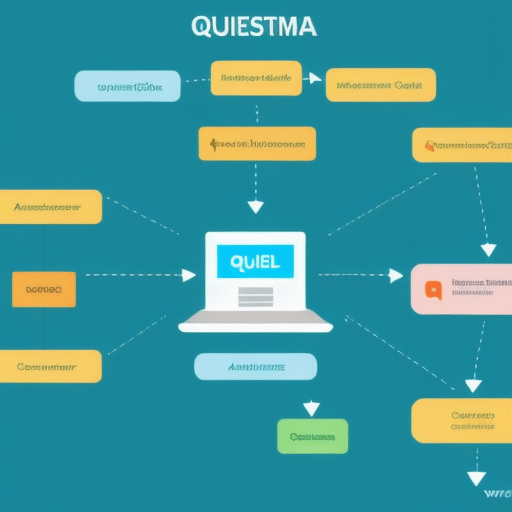La optimización de motores de búsqueda es una práctica crucial para cualquier sitio web que busque aumentar su visibilidad y tráfico en línea.
Una parte importante de esta estrategia es la creación de una sitemap HTML.
En este artículo, exploraremos qué es una sitemap HTML y por qué es importante tener una en tu sitio web.
También analizaremos los beneficios que ofrece, los pasos para crear una desde cero, las herramientas útiles para generarla automáticamente, los errores comunes al crearla y cómo evitarlos, así como su integración en tu estrategia de SEO y el monitoreo y actualización necesarios para un mejor rendimiento
¿Qué es una sitemap HTML y por qué es importante?
Una sitemap HTML es un archivo que contiene una lista de todas las páginas de un sitio web.
Es una herramienta útil para los motores de búsqueda, ya que les permite encontrar y rastrear todas las páginas del sitio.
Además, la sitemap HTML también ayuda a los visitantes del sitio a navegar fácilmente por él.
La importancia de tener una sitemap HTML radica en que mejora la visibilidad del sitio web en los resultados de búsqueda, lo que a su vez aumenta el tráfico orgánico al sitio.
Además, una sitemap HTML bien estructurada puede mejorar la experiencia del usuario al permitirles encontrar rápidamente lo que están buscando en el sitio.
Una sitemap HTML también puede ayudar a identificar problemas técnicos en el sitio, como páginas rotas o enlaces incorrectos.
En resumen, una sitemap HTML es una herramienta valiosa para cualquier sitio web que desee mejorar su visibilidad y usabilidad en línea.
Si bien no garantiza un mejor posicionamiento en los resultados de búsqueda, es un factor importante a considerar en cualquier estrategia de SEO
Beneficios de tener una sitemap HTML en tu sitio web
La sitemap HTML es un archivo que contiene una lista de todas las páginas de un sitio web y su estructura jerárquica.
Tener una sitemap HTML en tu sitio web tiene múltiples beneficios, entre ellos, mejora la indexación de tus páginas por los motores de búsqueda como Google.
Al proporcionar a los motores de búsqueda una guía clara y organizada del contenido de tu sitio web, aumentas la probabilidad de que tus páginas se indexen correctamente y aparezcan en los resultados de búsqueda relevantes para tus usuarios
Además, una sitemap HTML también ayuda a mejorar la experiencia del usuario al navegar por tu sitio web.
Si tu sitio web tiene muchas páginas, puede ser difícil para los usuarios encontrar lo que están buscando.
Una sitemap HTML les proporciona una vista general de todo el contenido disponible en tu sitio web y les permite navegar fácilmente a través de él
Otro beneficio importante de tener una sitemap HTML es que te ayuda a identificar y corregir problemas técnicos en tu sitio web.
Al monitorear regularmente tu sitemap HTML, puedes detectar rápidamente cualquier página rota o enlaces incorrectos y solucionarlos antes de que afecten negativamente la experiencia del usuario
En resumen, tener una sitemap HTML en tu sitio web es crucial para mejorar la visibilidad en los motores de búsqueda, mejorar la experiencia del usuario y mantener un sitio web técnica y funcionalmente saludable
Pasos para crear una sitemap HTML desde cero
La creación de una sitemap HTML puede parecer una tarea abrumadora, pero siguiendo algunos pasos simples, cualquier persona puede crear una sitemap HTML desde cero.
El primer paso es crear una lista completa de todas las páginas del sitio web.
Esto incluye todas las páginas principales, subpáginas y publicaciones de blog.
Una vez que se tiene la lista completa, se debe organizar en una estructura jerárquica para facilitar la navegación.
Después de esto, se debe crear un archivo XML con la lista organizada de todas las páginas del sitio web.
Este archivo XML se puede generar manualmente o mediante herramientas en línea.
A continuación, se debe convertir el archivo XML a formato HTML para que sea legible por los motores de búsqueda y los visitantes del sitio web.
Para ello, se puede utilizar un programa de edición de texto o un generador de sitemap HTML en línea.
Una vez que se ha creado la sitemap HTML, es importante verificar que todos los enlaces funcionen correctamente y que no haya errores en la estructura de la sitemap.
Finalmente, se debe subir el archivo HTML al servidor del sitio web y agregarlo a la sección de robots.txt para que los motores de búsqueda puedan encontrarlo fácilmente.
Con estos pasos simples, cualquier persona puede crear una sitemap HTML efectiva desde cero y mejorar la visibilidad y el rendimiento del sitio web en los motores de búsqueda
Herramientas útiles para generar una sitemap HTML automáticamente
Una sitemap HTML es un archivo que enumera todas las páginas de un sitio web para facilitar su indexación por los motores de búsqueda.
La creación de una sitemap HTML manualmente puede ser tediosa y propensa a errores, pero existen herramientas útiles para generarla automáticamente.
Una de las opciones más populares es el plugin Yoast SEO para WordPress, que crea una sitemap HTML de forma automática y la actualiza cada vez que se añade o elimina contenido en el sitio web.
Otra herramienta recomendada es XML Sitemap Generator, que permite generar sitemaps HTML y XML para sitios web con hasta 500 páginas de forma gratuita.
También está Screaming Frog, una herramienta que rastrea un sitio web y genera informes detallados sobre los enlaces internos y externos, las meta descripciones y títulos, así como una sitemap HTML completa.
Además, existen otras herramientas pagas como Ahrefs, SEMrush y Google Search Console, que ofrecen informes de análisis SEO completos y la posibilidad de crear sitemaps HTML y XML.
En conclusión, estas herramientas son muy útiles para ahorrar tiempo en la creación de una sitemap HTML y evitar errores al enumerar las páginas del sitio web
Errores comunes al crear una sitemap HTML y cómo evitarlos
La creación de una sitemap HTML puede mejorar significativamente la experiencia del usuario en un sitio web, así como su rendimiento en los motores de búsqueda.
Sin embargo, es común que se cometan errores al crear una sitemap.
Uno de los errores más frecuentes es no incluir todas las páginas relevantes del sitio web.
Es importante recordar que la sitemap debe contener todas las páginas importantes y no solo las principales.
Otro error común es incluir enlaces rotos o caducados en la sitemap, lo que puede afectar negativamente el SEO del sitio web.
Para evitar estos errores, es recomendable utilizar herramientas de auditoría de sitios web para identificar y corregir enlaces rotos antes de crear la sitemap.
Además, es importante asegurarse de que la sitemap sea legible para los motores de búsqueda y para los usuarios.
Se recomienda usar etiquetas XML y seguir las pautas de Google para garantizar que la sitemap sea fácilmente comprensible para los motores de búsqueda.
Por último, es importante actualizar regularmente la sitemap para reflejar los cambios en el sitio web y mantenerla actualizada.
Al evitar estos errores comunes al crear una sitemap HTML, se puede mejorar significativamente el rendimiento del sitio web y su posicionamiento en los motores de búsqueda
Cómo integrar la sitemap HTML en tu estrategia de SEO
La sitemap HTML es una herramienta valiosa para mejorar el SEO de tu sitio web.
Para integrarla en tu estrategia de SEO, primero debes asegurarte de que esté correctamente estructurada y actualizada.
Debes incluir todas las páginas relevantes de tu sitio web en la sitemap y asegurarte de que se indexen correctamente en los motores de búsqueda.
Además, debes incluir enlaces a tus páginas más importantes y relevantes para que los motores de búsqueda las identifiquen como prioritarias
Otro aspecto importante a considerar es la frecuencia con la que actualizas tu sitemap HTML.
Si agregas nuevas páginas o cambias la estructura del sitio, debes actualizar la sitemap para garantizar que los motores de búsqueda encuentren todo el contenido relevante y lo indexen correctamente
Además, puedes utilizar la sitemap HTML como una herramienta para identificar problemas técnicos en tu sitio web.
Si notas que hay páginas que no se están indexando correctamente o que tienen problemas de accesibilidad, puedes solucionarlos rápidamente y mejorar la calidad de tu sitio web
Por último, debes asegurarte de que tu sitemap HTML esté vinculada desde tu archivo robots.
txt para que los motores de búsqueda puedan encontrarla fácilmente.
También puedes incluir un enlace a tu sitemap HTML en el pie de página o menú principal de tu sitio web para facilitar su acceso a los usuarios
En resumen, integrar la sitemap HTML en tu estrategia de SEO es esencial para mejorar la visibilidad y el rendimiento de tu sitio web en los motores de búsqueda.
Al mantenerla actualizada y estructurada correctamente, puedes ayudar a los motores de búsqueda a encontrar y clasificar todo el contenido relevante de tu sitio web
Monitoreo y actualización de la sitemap HTML para un mejor rendimiento
La sitemap HTML es una herramienta valiosa para mejorar el SEO de tu sitio web.
Sin embargo, crear una sitemap no es suficiente para garantizar un mejor rendimiento.
Es importante monitorear y actualizar regularmente la sitemap para asegurarse de que esté funcionando correctamente y de que se estén incluyendo todas las páginas relevantes.
El monitoreo de la sitemap HTML implica verificar periódicamente si hay errores en la estructura o enlaces rotos.
Si se encuentran errores, deben corregirse de inmediato para evitar problemas de indexación y afectar negativamente el ranking del sitio en los motores de búsqueda.
Además, es importante revisar regularmente la sitemap para asegurarse de que se estén incluyendo nuevas páginas o eliminando las obsoletas
La actualización regular de la sitemap HTML también es crucial para garantizar un mejor rendimiento del SEO.
Cada vez que se agregue una nueva página o se realice un cambio importante en el sitio web, debe actualizarse la sitemap para informar a los motores de búsqueda sobre estos cambios.
De esta manera, se puede acelerar el proceso de indexación y mejorar el posicionamiento del sitio en los resultados de búsqueda
En resumen, monitorear y actualizar regularmente la sitemap HTML es esencial para mantener un alto rendimiento del SEO en tu sitio web.
Mantener una sitemap precisa y actualizada puede mejorar significativamente el posicionamiento del sitio y aumentar su visibilidad en los motores de búsqueda
En resumen, una sitemap HTML es una herramienta fundamental para cualquier sitio web que busque mejorar su rendimiento en motores de búsqueda y ofrecer una mejor experiencia de usuario.
A través de la creación y actualización constante de la sitemap, se puede asegurar que los motores de búsqueda encuentren todas las páginas importantes del sitio y las indexen correctamente.
Además, al evitar errores comunes en su creación y al integrarla adecuadamente en la estrategia de SEO, se pueden obtener beneficios significativos en términos de tráfico y visibilidad.
Sin embargo, es importante recordar que la sitemap no es un elemento aislado, sino que forma parte de un conjunto de acciones y estrategias que deben ser implementadas para lograr un mejor posicionamiento en línea.
¿Cómo podemos seguir mejorando nuestras prácticas de SEO y adaptándonos a los cambios constantes en el mundo digital?




